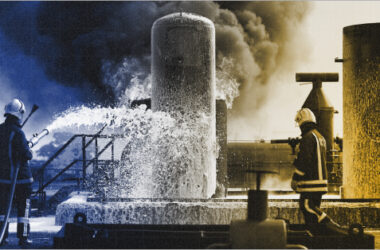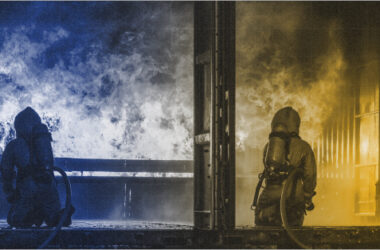We believe often you have heard or read about 12 perils of Fire Insurance. We have written this blog to make you aware about these 12 perils.
- Fire Perils: The policy provides coverage for damages caused directly by fire, excluding specific instances such as damage from fermentation, natural heating, spontaneous combustion, or heating processes. Additionally, damage resulting from orders by Public Authority is covered.
- Lightning Insurance: Losses incurred due to lightning strikes, including structural cracks, are covered.
- Explosion/Implosion: The policy safeguards against losses stemming from explosion or implosion, excluding damages to boilers, vessels, machinery, or apparatus generating steam.
- Aircraft Damage: Damage caused by aircraft or aerial devices is covered.
- Riot, Strike, Malicious Damage: Losses due to external violent acts, such as rioting, strikes, or malicious damage, are included.
- Storm, Cyclone, Typhoon, Flood: Destruction caused by storms, cyclones, typhoons, or floods is covered, except for earthquakes or volcanic eruptions.
- Impact Damage: Direct damages from rail/road vehicles or animals, excluding those owned by the insured or their associates, are covered.
- Subsidence and Landslide: Losses due to subsidence or landslide, excluding certain causes like demolition or coastal erosion, are covered.
- Bursting and/or Overflowing of Water Tanks, Apparatus, and Pipes: Damage caused by bursting or overflowing water tanks, apparatus, or pipes is covered.
- Missile Testing Operations: Damage resulting from missile testing operations is covered.
- Leakage from Automatic Sprinkler Installations: Accidental water discharge from automatic sprinkler installations is covered, excluding specific instances like repairs or defects known to the insured.
- Bush Fire: Damage from burning bushes and jungles is covered, excluding losses from forest fires.
Case Study: Application of Standard Fire Insurance Perils
A cloth manufacturer in Midnapore, specializing in exporting handcrafted goods, faced a fire incident in their factory, causing substantial damage to their stock. Despite the severity of the situation, no injuries were reported, and the fire brigade promptly contained the blaze.
Having secured a Fire Insurance Policy, the manufacturer reached out to their insurers, who dispatched a surveyor to assess the damage. Following investigation, it was determined that the fire fell under one of the 12 perils specified in the policy.
As the incident was covered under the insured perils, the insurance company duly compensated the cloth manufacturer for their losses, ensuring minimal disruption to their business operations.
For Small and Medium Enterprises (SMEs) or startups, the financial repercussions of fire damage can be severe and potentially disrupt business operations. Fire Insurance plays a critical role in mitigating these risks by providing funds for replacements or repairs, thereby ensuring continuity of business activities. While many Fire Insurance Policies offer coverage for the perils mentioned earlier, seeking guidance from an expert before finalizing a policy for your business is strongly recommended. This ensures that you select a policy tailored to your specific needs and circumstances, providing comprehensive protection against potential fire-related losses.
The Importance of Standard Fire and Special Perils Insurance Policy:
Fire-related accidents pose significant risks to businesses, with even small incidents like a short-circuit or explosion capable of causing extensive damage to factories and buildings. The aftermath of such events can result in colossal financial losses, potentially wiping out years of savings and setting back business operations significantly.
Furthermore, recovering from a fire incident demands substantial investments to rebuild and restore business operations. These investments come at a time when resources are already stretched thin due to the destruction caused by the fire.
In light of these risks and challenges, it is prudent for businesses to safeguard their valuable assets by obtaining a property insurance policy, specifically a Fire Insurance Policy. This type of insurance provides crucial financial protection against fire-related losses, ensuring that businesses can recover and resume operations without facing debilitating financial burdens.
Fire Insurance Policy Add-on Covers
- Damages due to earthquake
- Damages due to Storm, Tempest, Flood, Inundation, Hurricane, Cyclone, Typhoon, and Tornado (STFI Cover)
- Damages due to Terrorism
- Removal of Debris
- Architects and Surveyors Fees
- Spontaneous Combustion Cover
- Start-Up Expenses
- Omission to Insure Additions, Alterations, or Extensions
- Escalation
- Forest Fire
Types of Fire Insurance Policies:
- Stock Declaration Policy: Requires monthly declarations of stock values when there are frequent changes in stock value.
- Floater Policy: Covers stocks stored at different locations with a single declared sum insured.
- Average Policy: Comes into play when the insured property is underinsured, resulting in a pro-rata claim amount.
- Agreed Value Policy: Pre-decided value for hard-to-value assets, ensuring a predetermined payout in case of damage or destruction.
Bharat Sookshma Udyam Suraksha Policy (BSUS Policy):
A standard Fire Insurance Policy tailored for SMEs and small businesses, covering assets such as buildings, machinery, and furniture for loss or damage due to fire, explosion, natural calamities, etc. The policy can be purchased if the total value of insurable assets is less than or equal to Rs 5 Crores.
Bharat Laghu Udyam Suraksha Policy (BLUS Policy):
A standard Fire Insurance Policy designed for medium-sized businesses with insurable assets up to Rs 50 Crores, covering assets such as buildings, machinery, and stocks for loss or damage due to various perils. It can be purchased if the total value of insurable assets is between Rs 5 Crores to Rs 50 Crores.
Insurable Assets with a Fire Insurance Policy:
Factories (Plant & Machinery), Residential or Commercial Property Buildings, Stocks and Inventory, Furniture, Fixtures, and Fittings, among others.
Premium Calculation Factors:
- Sum Insured of the Property
- Perils to be Covered.
- Risk Occupancy of the Property
- Location Details of the Property
- Selected Add-On Covers
Determining the Sum Insured in a Fire Insurance Policy:
When determining the Sum Insured for a Fire Insurance Policy, there are two primary methods:
- Reinstatement Value Method (RIV Method): Under this method, the Insurance Company reimburses the cost of replacing the damaged property with a new property in the event of a claim. Depreciation is not factored into the property value under this approach. It is important to note that the RIV Method applies exclusively to fixed assets and not to stocks and contents.
- Market Value Method: With the Market Value Method, the Insurance Company compensates for the market value (depreciated value) of the insured property in case of a claim. Depreciation is considered based on the asset’s age. This method considers the current market value of the property, factoring in any depreciation over time.
These methods offer different approaches to determining the appropriate Sum Insured for a Fire Insurance Policy, providing flexibility in addressing various types of assets and their valuation considerations.








